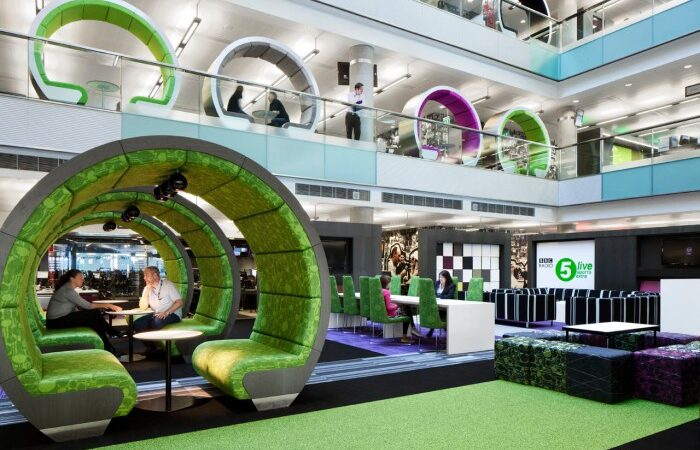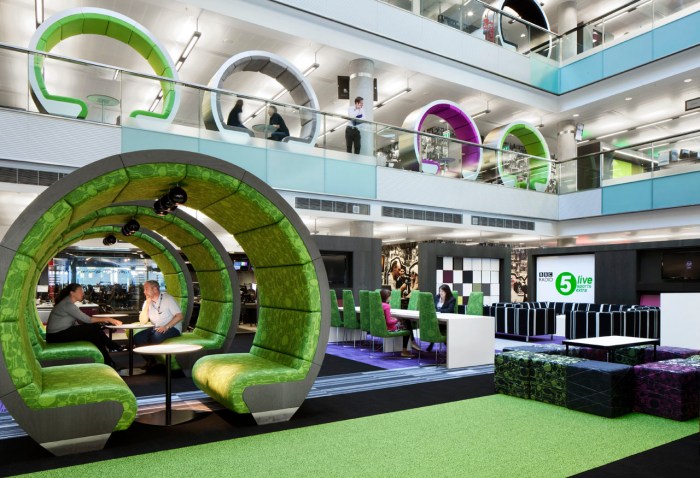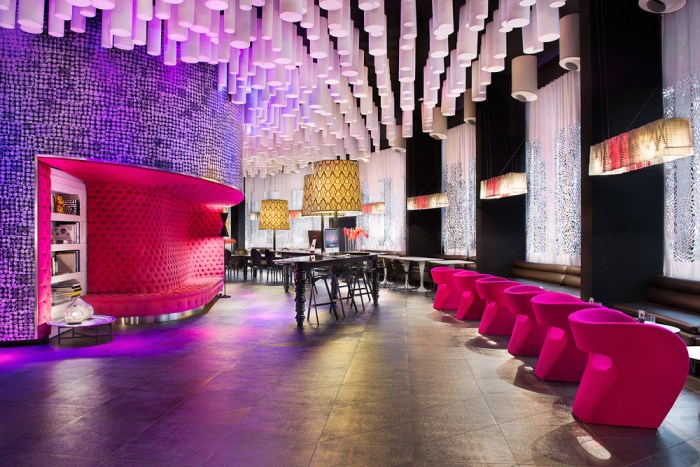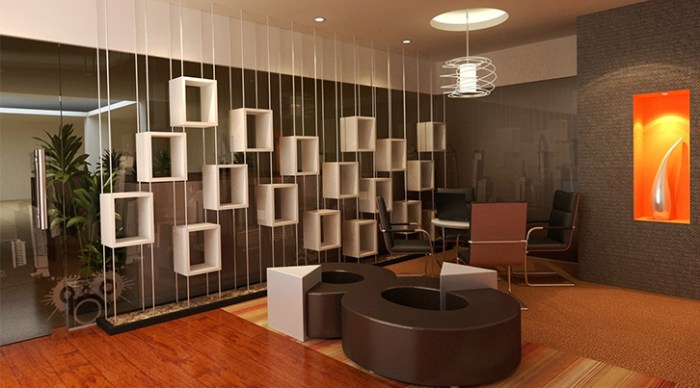Innovative Interiors: Shaping Modern Living Spaces

Innovative interiors set the stage for this enthralling narrative, offering readers a glimpse into a story that is rich in detail and brimming with originality from the outset. The realm of interior design is constantly evolving, embracing new technologies and materials to create spaces that are not only aesthetically pleasing but also functional, sustainable, and responsive to the changing needs of modern life.
This exploration delves into the fascinating world of innovative interiors, examining how designers are pushing the boundaries of traditional design principles to create spaces that are both stylish and forward-thinking. We’ll explore the key elements that define innovative interiors, from the use of cutting-edge materials and finishes to the integration of smart home technology and the optimization of space utilization.
Defining Innovative Interiors
Innovative interior design goes beyond simply creating aesthetically pleasing spaces. It embraces a forward-thinking approach, integrating functionality, sustainability, and cutting-edge technology to craft environments that enhance our lives and adapt to our evolving needs.
Distinguishing Features of Innovative Interiors
Innovative interiors are characterized by several key elements that set them apart from traditional design approaches. These include:
- Functionality and User Experience: Innovative interiors prioritize functionality and user experience. They focus on creating spaces that are both visually appealing and practical, catering to the specific needs and preferences of the occupants. This might involve incorporating smart home technologies, flexible furniture arrangements, and ergonomic design elements.
- Sustainability and Environmental Responsibility: Sustainability is a core principle of innovative interior design. Designers prioritize using eco-friendly materials, reducing waste, and minimizing environmental impact. This might involve choosing sustainable building materials, incorporating energy-efficient lighting and appliances, and optimizing natural ventilation.
- Technological Integration: Innovative interiors seamlessly integrate technology to enhance functionality, comfort, and connectivity. This could include smart lighting systems that adjust to natural light, automated climate control, and integrated audio-visual systems.
- Adaptive and Flexible Design: Innovative interiors are designed to be adaptable and flexible, catering to changing needs and preferences over time. This might involve using modular furniture, multi-functional spaces, and open floor plans that can be easily reconfigured.
Examples of Innovative Interior Design Trends, Innovative interiors
Several emerging trends exemplify the principles of innovative interior design:
- Biophilic Design: This trend emphasizes incorporating natural elements, such as plants, natural light, and organic materials, into interior spaces. It aims to create a sense of connection to nature and promote well-being.
- Minimalism and Decluttering: Minimalist design focuses on creating clean, uncluttered spaces with a focus on functionality and simplicity. It emphasizes the use of natural materials, neutral colors, and open floor plans.
- Smart Home Technology: Smart home technology integrates seamlessly with interior design, providing features like voice-activated lighting, automated climate control, and remote access to appliances and security systems.
- Sustainable Materials: The use of sustainable materials, such as bamboo, recycled plastics, and reclaimed wood, is becoming increasingly popular in innovative interior design. These materials offer both environmental benefits and unique aesthetic qualities.
Technology’s Influence on Innovative Interiors
Technology plays a pivotal role in shaping the evolution of innovative interiors. Advancements in materials, manufacturing, and digital design tools have enabled designers to create more sustainable, functional, and personalized spaces.
- 3D Modeling and Virtual Reality: These technologies allow designers to create detailed virtual representations of spaces, enabling clients to experience the design before construction begins. This facilitates collaboration, reduces errors, and allows for greater customization.
- Smart Home Automation: Smart home technology offers unparalleled control over lighting, temperature, security, and other aspects of the living environment. This allows for greater personalization, energy efficiency, and enhanced comfort.
- Sustainable Materials and Manufacturing: Technological advancements have led to the development of new sustainable materials, such as bio-based plastics and recycled composites. These materials offer environmental benefits while maintaining aesthetic appeal.
- Artificial Intelligence and Data Analytics: AI and data analytics are being used to optimize interior design solutions. This includes analyzing user behavior patterns to create personalized spaces and predicting future trends in design preferences.
Materials and Finishes

Innovative interiors are not only about aesthetics and functionality but also about sustainability and responsible resource management. The use of sustainable and eco-friendly materials is becoming increasingly crucial in interior design, as it reflects a shift towards a more conscious and environmentally responsible approach.
This section explores the integration of sustainable materials and advanced technologies in creating innovative interiors.
Sustainable Materials
Sustainable materials are those that are sourced and produced in a way that minimizes their environmental impact. These materials often have a lower carbon footprint, require less energy to produce, and are less harmful to human health.
- Recycled Materials: Recycled materials, such as recycled plastic, glass, and wood, offer a sustainable alternative to virgin materials. Their use reduces the demand for new resources and minimizes waste. Examples include using recycled plastic for furniture, countertops, and flooring, and incorporating recycled glass in tiles and decorative elements.
- Natural Materials: Natural materials like bamboo, cork, and wool are renewable and biodegradable. They provide a warm and natural aesthetic and have a lower environmental impact than synthetic materials. Bamboo is a fast-growing and sustainable alternative to traditional hardwoods, often used for flooring, furniture, and wall coverings. Cork is a naturally resilient material used for flooring, wall panels, and furniture, offering excellent insulation and acoustic properties. Wool is a natural fiber known for its thermal insulation and breathability, making it ideal for rugs, upholstery, and wall coverings.
- Bio-based Materials: Bio-based materials are derived from renewable plant and agricultural sources, offering a sustainable alternative to petroleum-based products. Examples include bio-based polymers derived from corn starch, used for furniture, flooring, and wall panels. These materials offer similar performance to traditional plastics but with a lower environmental footprint.
Advanced Materials
Advanced materials offer unique properties and capabilities that enhance the performance and aesthetics of innovative interiors.
- Bio-based Polymers: Bio-based polymers are derived from renewable plant sources and offer a sustainable alternative to traditional plastics. They are lightweight, durable, and have excellent thermal and acoustic insulation properties. These polymers can be used for various applications, including furniture, wall panels, and flooring.
- Recycled Materials: Recycled materials, such as recycled plastic, glass, and metal, are increasingly used in innovative interiors. They offer a sustainable and cost-effective alternative to virgin materials. Recycled plastic can be used for furniture, countertops, and flooring, while recycled glass can be incorporated into tiles and decorative elements. Recycled metal can be used for lighting fixtures, furniture, and decorative accents.
- Smart Materials: Smart materials are responsive to changes in their environment, such as temperature, light, or pressure. These materials can be used to create adaptive and interactive interiors, responding to user needs and environmental conditions. For example, thermochromic paints change color based on temperature, creating dynamic and responsive spaces. Photochromic glass darkens in response to sunlight, providing natural shading and energy efficiency.
Innovative Surface Treatments and Finishes
Innovative surface treatments and finishes play a crucial role in creating unique and functional interiors.
- Nanotechnology: Nanotechnology can be used to create durable and water-resistant coatings for surfaces, enhancing their performance and lifespan. Nanotech coatings can be applied to various materials, including wood, metal, and glass, protecting them from scratches, stains, and UV damage. They can also improve the fire resistance and antimicrobial properties of surfaces.
- Digital Printing: Digital printing allows for the creation of customized and intricate patterns on various surfaces, including walls, floors, and furniture. This technology enables designers to create unique and personalized interiors that reflect the individual style and preferences of the occupants.
- Sustainable Finishes: Sustainable finishes are made from natural and non-toxic materials, reducing the environmental impact of interior design. Examples include natural waxes and oils for wood finishes, water-based paints, and low-VOC (volatile organic compounds) adhesives. These finishes offer a healthier and more sustainable alternative to traditional finishes.
Space Optimization and Functionality
In the realm of innovative interior design, optimizing space utilization is paramount, particularly in urban environments where living spaces are often limited. Innovative design approaches prioritize functionality and efficiency, maximizing every square foot to create comfortable and livable environments.
Space-Saving Solutions for Small Apartments
Designing a small apartment that maximizes functionality requires a strategic approach. Here are some innovative space-saving solutions:
- Multi-functional furniture: This approach utilizes furniture that serves multiple purposes, such as a sofa that transforms into a bed, a coffee table with storage, or a dining table that folds away.
- Vertical storage: Maximizing vertical space is key in small apartments. This can be achieved through built-in shelves, wall-mounted organizers, and ceiling-high cabinets.
- Open floor plans: Open floor plans eliminate walls, creating a sense of spaciousness and flow. This approach allows for flexibility in furniture placement and creates a visual connection between different areas of the apartment.
- Mirrors: Mirrors reflect light, making spaces appear larger and brighter. Strategic placement of mirrors can also create the illusion of depth and expand the visual space.
- Compact appliances: Smaller appliances, such as mini-fridges, compact washing machines, and space-saving ovens, can significantly reduce the footprint of kitchen and laundry areas.
For example, a small studio apartment could incorporate a Murphy bed that folds away into a wall unit, creating a living room during the day and a bedroom at night. A kitchen island could double as a dining table, and a built-in bookcase could be designed to include storage for kitchen supplies.
Mirrors placed strategically on walls would amplify natural light and create the illusion of more space.
Traditional vs. Innovative Furniture Design for Multi-functional Spaces
Traditional furniture design often focuses on individual pieces with specific functions. Innovative approaches, however, prioritize furniture that serves multiple purposes.
Traditional Approach:
- Separate pieces for each function, such as a sofa, coffee table, and TV stand.
- Limited flexibility in arrangement and space utilization.
- Potential for clutter and inefficient use of space.
Innovative Approach:
- Multi-functional furniture that combines multiple uses, such as a sofa bed, a coffee table with storage, or a wall unit that incorporates a desk, shelves, and a TV stand.
- Increased flexibility in arrangement and space utilization.
- Reduced clutter and optimized use of space.
For example, a traditional living room might have a separate sofa, coffee table, TV stand, and bookshelves. An innovative approach might incorporate a modular sofa that transforms into a bed, a coffee table with built-in storage, and a wall unit that includes a TV stand, shelves, and a desk.
This approach creates a more efficient use of space and provides flexibility for different activities.
Lighting and Atmosphere

Lighting plays a crucial role in shaping the ambiance and functionality of any interior space. It goes beyond simply illuminating a room; it influences mood, perception, and the overall user experience. Innovative interiors leverage lighting strategically to create dynamic and inviting atmospheres that enhance the space’s purpose and appeal.
Innovative Lighting Technologies
Modern lighting technologies offer a wide range of possibilities to elevate interior design. These technologies go beyond traditional incandescent bulbs and fluorescent tubes, introducing new ways to control light, enhance energy efficiency, and create captivating visual effects.
- LED Lighting: LED (Light Emitting Diode) technology has revolutionized lighting in recent years. LEDs are highly energy-efficient, long-lasting, and offer a wide range of color temperatures and brightness levels. This versatility allows for precise control over the ambiance, from warm and inviting to cool and stimulating.
- Smart Lighting Systems: Smart lighting systems allow for remote control and automation of lighting fixtures. Users can adjust brightness, and color, and even schedule lighting patterns using mobile apps or voice commands. This technology offers convenience, energy savings, and personalized lighting experiences.
- Dynamic Lighting: Dynamic lighting systems use programmable LED fixtures to create dynamic lighting effects that change over time. These systems can simulate natural daylight patterns, create rhythmic lighting sequences, or respond to user interaction. Dynamic lighting can enhance the visual appeal of a space and create engaging experiences.
- Biodynamic Lighting: Biodynamic lighting aims to mimic natural daylight cycles, providing lighting that aligns with the body’s circadian rhythm. This approach can improve sleep quality, reduce eye strain, and enhance overall well-being.
Smart Home Integration
Smart home technology has become an integral part of innovative interiors, seamlessly blending functionality and comfort to create a truly enriching living experience. By integrating intelligent systems into the home environment, innovative interiors enhance convenience, energy efficiency, and overall well-being.
Smart Home Features and Their Impact
Smart home features offer a range of benefits that contribute to a seamless and comfortable living experience. These features can be categorized into various areas, each playing a vital role in enhancing the functionality and convenience of innovative interiors.
- Smart Lighting: Smart lighting systems offer the ability to control lighting levels, color temperature, and schedules, creating a personalized and dynamic ambiance. For instance, smart lighting can automatically adjust brightness based on natural light levels, creating a comfortable and energy-efficient environment throughout the day. Additionally, smart lighting can be integrated with other smart home features, such as security systems, to enhance safety and security.
- Climate Control: Smart thermostats and HVAC systems enable precise temperature control, optimizing energy efficiency and comfort. Smart thermostats can learn user preferences and automatically adjust temperature settings based on occupancy, weather conditions, and other factors. This intelligent control reduces energy consumption and contributes to a comfortable living environment.
- Security Systems: Smart security systems offer advanced features, such as remote monitoring, motion detection, and door and window sensors. These systems can be integrated with smart lighting and other devices to create a comprehensive security solution. For example, smart lighting can be programmed to automatically turn on when motion is detected, deterring potential intruders. Additionally, homeowners can remotely monitor their security systems from anywhere using their smartphones or tablets, providing peace of mind and enhanced security.
Smart Home Integration Scenario
Imagine a scenario where you are away from home and receive a notification on your smartphone that your front door is unlocked. Using your smart home app, you can remotely lock the door, ensuring your home’s security. Additionally, you can adjust the temperature in your home remotely to ensure it is comfortable upon your return.
Smart home integration enables seamless control and monitoring of your home environment, providing peace of mind and convenience.
The Future of Innovative Interiors

The world of interior design is constantly evolving, driven by technological advancements, shifting societal needs, and a growing desire for personalized and sustainable spaces. Innovative interiors are at the forefront of this evolution, incorporating cutting-edge technologies and design principles to create spaces that are not only aesthetically pleasing but also functional, adaptable, and responsive to the needs of their inhabitants.
Emerging Trends in Innovative Interior Design
The rapid pace of technological innovation is shaping the future of interior design. Emerging trends are driven by the convergence of artificial intelligence, virtual reality, and sustainable design principles.
- AI-powered Design and Personalization: Artificial intelligence is transforming the way we design and personalize our spaces. AI-powered design tools can analyze user preferences, lifestyle data, and environmental factors to generate personalized design solutions. These tools can create custom layouts, select appropriate materials, and even recommend furniture and décor that aligns with individual tastes and needs. For example, a homeowner could use an AI-powered app to design a kitchen that is tailored to their cooking habits, dietary preferences, and storage needs. This level of personalization enhances the user experience and creates spaces that are truly tailored to individual lifestyles.
- Virtual Reality and Augmented Reality: Virtual reality (VR) and augmented reality (AR) are revolutionizing the way we experience and interact with our spaces. VR allows users to virtually explore and interact with different design concepts before making any physical changes. This immersive experience provides a realistic preview of how a space will look and feel, reducing the risk of costly design mistakes.AR, on the other hand, overlays digital information in the real world, allowing users to visualize furniture, décor, and other elements in their existing spaces. This technology is particularly useful for home staging, renovation planning, and furniture selection.
- Sustainable and Eco-Friendly Design: Sustainability is becoming increasingly important in all aspects of our lives, and interior design is no exception. Innovative interiors are embracing sustainable materials, energy-efficient technologies, and responsible sourcing practices. This includes using recycled and reclaimed materials, incorporating green building principles, and implementing smart home systems that optimize energy consumption. For example, using bamboo flooring, solar panels, and smart lighting systems that automatically adjust to natural light levels contributes to creating a more sustainable and environmentally responsible living environment.
- Biophilic Design: Biophilic design, which incorporates elements of nature into built environments, is gaining popularity as people seek to connect with the natural world. This trend involves using natural materials, incorporating greenery, and creating spaces that promote a sense of well-being. Biophilic design principles can be applied to both residential and commercial spaces, creating a more calming and inspiring atmosphere. For example, incorporating living walls, natural light, and views of nature can significantly improve the mood and productivity of occupants.
- Multifunctional Spaces: As urban living spaces become smaller and more expensive, the demand for multifunctional spaces is growing. Innovative interiors are designed to maximize space utilization and accommodate multiple activities within a single room. This involves using flexible furniture, creating hidden storage solutions, and incorporating smart technology that adapts to different needs. For example, a living room can be transformed into a home office, a guest room, or a media center with the use of foldable furniture, smart lighting, and multi-functional appliances.
The Impact of Artificial Intelligence and Virtual Reality
Artificial intelligence (AI) and virtual reality (VR) are poised to revolutionize the interior design industry, transforming how we design, experience, and interact with our spaces.
- AI-driven Design Tools: AI-powered design tools can analyze vast amounts of data, including user preferences, lifestyle habits, and environmental factors, to generate personalized design solutions. These tools can create custom layouts, select appropriate materials, and even recommend furniture and décor that aligns with individual tastes and needs. This level of personalization allows for a more tailored and intuitive design process, creating spaces that are truly responsive to the needs and preferences of their inhabitants.
- Virtual Reality for Immersive Design: Virtual reality (VR) offers a revolutionary approach to experiencing design concepts. VR allows users to virtually explore and interact with different design ideas before making any physical changes. This immersive experience provides a realistic preview of how a space will look and feel, reducing the risk of costly design mistakes and empowering users to make informed decisions about their design choices.
- Augmented Reality for Real-time Visualization: Augmented reality (AR) overlays digital information in the real world, allowing users to visualize furniture, décor, and other elements in their existing spaces. This technology is particularly useful for home staging, renovation planning, and furniture selection. AR allows users to see how different design elements will look in their space before committing to any purchases, reducing the risk of disappointment and ensuring that the chosen items fit seamlessly into the existing environment.
- AI-powered Personalization and Automation: AI can personalize and automate various aspects of interior design, from lighting and temperature control to music selection and home security. Smart home systems powered by AI can learn user preferences and adjust settings automatically, creating a more comfortable and convenient living environment. For example, AI-powered lighting systems can adjust brightness and color temperature based on the time of day, user activity, and even mood.
Ending Remarks
As we venture into the future of innovative interiors, we can expect to see even more remarkable advancements. The convergence of technology, sustainability, and design will continue to shape the spaces we inhabit, creating environments that are not only aesthetically pleasing but also enhance our well-being and connect us to the world around us.
The future of innovative interiors is bright, promising a world where our living spaces are not just places to live, but also dynamic, responsive, and enriching experiences.
Comments are closed.